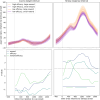Reward and Efficacy Modulate the Rate of Anticipatory Pupil Dilation
- PMID: 39791288
- PMCID: PMC11718623
- DOI: 10.1111/psyp.14761
Reward and Efficacy Modulate the Rate of Anticipatory Pupil Dilation
Abstract
Pupil size is a well-established marker of cognitive effort, with greater efforts leading to larger pupils. This is particularly true for pupil size during task performance, whereas findings on anticipatory effort triggered by a cue stimulus are less consistent. For example, a recent report by Frömer et al. found that in a cued-Stroop task, behavioral performance and electrophysiological markers of preparatory effort allocation were modulated by cued reward and 'efficacy' (the degree to which rewards depended on good performance), but pupil size did not show a comparable pattern. Here, we conceptually replicated this study, employing an alternative approach to the pupillometry analyses. In line with previous findings, we found no modulation of absolute pupil size in the cue-to-target interval. Instead, we observed a significant difference in the rate of pupil dilation in anticipation of the target: pupils dilated more rapidly for high-reward trials in which rewards depended on good performance. This was followed by a significant difference in absolute pupil size within the first hundreds of milliseconds following Stroop stimulus onset, likely reflecting a lagging effect of anticipatory effort allocation. Finally, the slope of pupil dilation was significantly correlated with behavioral response times, and this association was strongest for the high-reward, high-efficacy trials, further supporting that the rate of anticipatory pupil dilation reflects anticipatory effort. We conclude that pupil size is modulated by anticipatory effort, but in a highly temporally-specific manner, which is best reflected by the rate of dilation in the moments just prior to stimulus onset.
Keywords: efficacy; effort; preparatory control; pupillometry; reward.
© 2025 The Author(s). Psychophysiology published by Wiley Periodicals LLC on behalf of Society for Psychophysiological Research.
Conflict of interest statement
The authors declare no conflicts of interest.
Figures





References
-
- Alnaes, D. , Sneve M. H., Espeseth T., Endestad T., Van De Pavert S. H. P., and Laeng B.. 2014. “Pupil Size Signals Mental Effort Deployed During Multiple Object Tracking and Predicts Brain Activity in the Dorsal Attention Network and the Locus Coeruleus.” Journal of Vision 14, no. 4: 1. 10.1167/14.4.1. - DOI - PubMed
MeSH terms
Grants and funding
LinkOut - more resources
Full Text Sources

